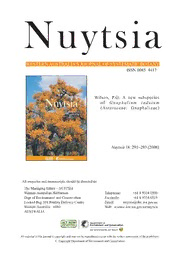
A new subspecies of Gnaphalium indutum (Asteraceae: Gnaphalieae) PDF
Preview A new subspecies of Gnaphalium indutum (Asteraceae: Gnaphalieae)
N u y t s i a WESTERN AUSTRALIA'S JOURNAL OF SYSTEMATIC BOTANY ISSN 0085–4417 Wilson, P.G. A new subspecies of Gnaphalium indutum (Asteraceae: Gnaphalieae) Nuytsia 18: 291–293 (2008) All enquiries and manuscripts should be directed to: The Managing Editor – NUYTSIA Western Australian Herbarium Telephone: +61 8 9334 0500 Dept of Environment and Conservation Facsimile: +61 8 9334 0515 Locked Bag 104 Bentley Delivery Centre Email: [email protected] Western Australia 6983 Web: science.dec.wa.gov.au/nuytsia AUSTRALIA All material in this journal is copyright and may not be reproduced except with the written permission of the publishers. © Copyright Department of Environment and Conservation NP.uGy.t sWiai l1so8n: ,2 A91 n–e2w9 3s u(b2s0p0e8c)ies of Gnaphalium indutum 291 A new subspecies of Gnaphalium indutum (Asteraceae: Gnaphalieae) Paul G. Wilson Western Australian Herbarium, Department of Environment and Conservation, Locked Bag 104, Bentley Delivery Centre, Western Australia 6983 Abstract Wilson, P.G. A new subspecies of Gnaphalium indutum (Asteraceae: Gnaphalieae). Nuytsia 18: 291–293 (2008). Gnaphalium indutum Hook.f. is considered to consist of two infraspecific taxa, subsp. indutum and subsp. acuminatum Paul G.Wilson subsp. nov. The latter is predominantly an inland taxon of non-saline habitats. Taxonomy Gnaphalium indutum Hook.f., London J. Bot. 6:121(1847). Type: Circular Head, Tasmania, 15 November 1836, R.C. Gunn 839 (holo: K n.v., photo PERTH). Rounded, cottony, multistemmed annual to 10 cm high. Stems weak, wiry. Leaves linear to linear- spathulate, obtuse, 5–10(–20) mm long. Capitula in upper axils, subsessile to slender-pedunculate forming globose corymbs, often subtended by leafy bracts that sometimes well exceed the capitula. Involucres cup-shaped, 2–3 mm high; outer bracts ovate, somewhat woolly, intermediate and inner bracts narrowly oblong to narrowly elliptic, acute or acuminate, sometimes minutely serrulate towards apex, sparsely woolly over the narrowly oblong stereome, straw-coloured or purple towards apex. Bisexual florets 4–6; corollas purple tipped. Achenes c. 0.7 mm long with minute, clavate, myxogenic duplex hairs. Distribution. Found in southern Australia from the Abrolhos Islands, Western Australia, to far south- eastern New South Wales and Tasmania. Two subspecies are recognised. 1. Inner involucral bracts obtuse to acute or evenly acuminate, the apices flat, entire, smooth ......................................................................................................................subsp. indutum 1: Inner involucral bracts abruptly acuminate, the apices inwardly concave, denticulate, scabridulous ...............................................................................................subsp. acuminatum 292 Nuytsia Vol. 18 (2008) Gnaphalium indutum Hook.f. subsp. indutum G. sericeum Turcz., Bull. Soc. Imp. Naturalistes Moscou 24/2: 83(1851). Type: south-west Western Australia, J. Drummond 5th coll. n. 392 (iso: MEL 293593, MEL 283445, PERTH 00756547). Inner involucral bracts obtuse to acute or evenly acuminate; apex smooth and flat, entire, pale yellowish or pale red, often reddish below apex as stripes on either side of stereome. Florets 20–30. Pappus bristles not, or only slightly, broadened at base where weakly united and soon free, caducous. Distribution. Found in Tasmania and mainly coastal or near coastal southern Australia from the Abrolhos Islands, Western Australia, to far south-eastern New South Wales, also inland Victoria and inland south and south-eastern South Australia. Habitat. Found around coastal and near coastal salt lakes, but also collected in areas that have not been noted as being saline. Selected specimens examined. WESTERN AuSTRALIA: Walpole-Nornalup National Park, 25 Sep. 1992, J.R. Wheeler 3324 (PERTH). SouTH AuSTRALIA: False Cape, Kangaroo Is., B.M. Overton 892 (AD). NEW SouTH WALES: Mowarry Point, 3 oct. 1975, A. Slee (CANB). VICToRIA: Port Fairy, oct. 1889, H.B. Williamson (CANB). TASMANIA: Cape Portland, A. Moscal 3178 (Ho). Notes. As delimited here this subspecies is somewhat variable morphologically. The pappus bristles are sometimes not at all broadened at base and are then virtually free, while sometimes they are slightly broadened and weakly connate. This morphological variability, along with the diverse habitats, suggests that there may be more than one taxon included under this name. Gnaphalium indutum subsp. acuminatum Paul G.Wilson, subsp. nov. Ab subsp. induto bracteis involucri abrupte acuminatis, ad apicem minute scabridulis, denticulatis, rubescentibus vel lutescentibus, setis pappi ad basim latioribus differt. Typus: Dookie College of Agriculture, Victoria, 2 November 1992, J.E. Strudwick 909 (holo: MEL; iso: CANB). Inner involucral bracts abruptly acuminate; apical portion minutely scabridulous, denticulate, inwardly concave, reddish or becoming yellowish at tip, the colouration not extending downwards to the stereome. Florets c. 50. Pappus bristles noticeably broadened and shortly united at base, persistent or semi-persistent. Distribution. Found in inland areas of Victoria (rarely near-coastal) and in the extreme south-central area of New South Wales. Habitat. Occurs in woodland and scrub in non-saline soils. P.G. Wilson, A new subspecies of Gnaphalium indutum 293 Selected specimens examined. NEW SouTH WALES: The Rocks, between Berrigan and Tocumwal, oct. 1979, W.E. Mulham (NSW). VICToRIA: Puckapunyal, 1.7 km NNE of Mt Disappointment, R.J. Adair 2090 (MEL); 6.5 km SE of Seaton, D.E. Albrecht 1923 (MEL); Mt Arapiles, A.C. Beauglehole 16641 (MEL); Brisbane Range National Park, A.C. Beauglehole 56659 (MEL); Glenmaggie Regional Park, A.C. Beauglehole 78623 (MEL); Warby Ranges State Park, A.C. Beauglehole 80793 (MEL); Cosstick Reserve, 2 miles (c. 3 km) west of Maryborough, T.B. Muir 1466 (MEL); Euroa, R. Thomas 343 (MEL); St Leonards, Bellarine Peninsula, 9 Nov. 1947, J.H. Willis (MEL); Batesford, 11 Oct. 1981, J.H. Willis (MEL). Notes. The only coastal or near-coastal collection of this subspecies was that made by J.H. Willis at St Leonards (see above), where it was found growing on ‘wet flats under Red Gum’. Willis noted that it was a form ‘with acuminate and apically laciniate bracts and more papillose achenes than in the usual, typical form’. Acknowledgements Work on the genus Gnaphalium L. was carried out while the author was in receipt of a grant from the Australian Biological Resources Study. 294 Nuytsia Vol. 18 (2008)
